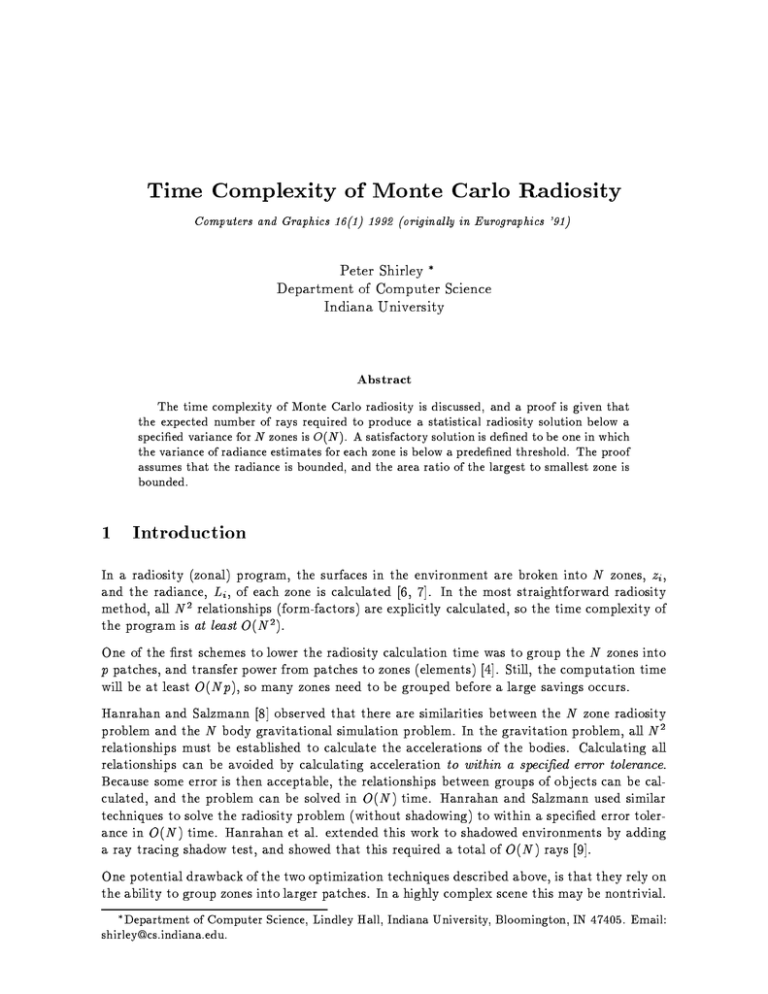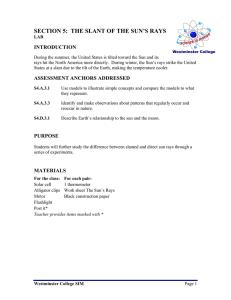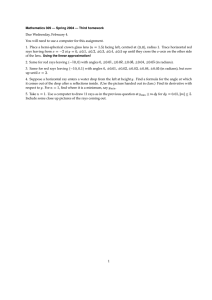Time Complexity of Monte Carlo Radiosity Peter Shirley Department of Computer Science
advertisement

Time Complexity of Monte Carlo Radiosity
Computers and Graphics 16(1) 1992 (originally in Eurographics '91)
Peter Shirley Department of Computer Science
Indiana University
Abstract
The time complexity of Monte Carlo radiosity is discussed, and a proof is given that
the expected number of rays required to produce a statistical radiosity solution below a
specied variance for N zones is O(N ). A satisfactory solution is dened to be one in which
the variance of radiance estimates for each zone is below a predened threshold. The proof
assumes that the radiance is bounded, and the area ratio of the largest to smallest zone is
bounded.
1 Introduction
In a radiosity (zonal) program, the surfaces in the environment are broken into N zones, zi ,
and the radiance, Li , of each zone is calculated [6, 7]. In the most straightforward radiosity
method, all N 2 relationships (form-factors) are explicitly calculated, so the time complexity of
the program is at least O(N 2).
One of the rst schemes to lower the radiosity calculation time was to group the N zones into
p patches, and transfer power from patches to zones (elements) [4]. Still, the computation time
will be at least O(Np), so many zones need to be grouped before a large savings occurs.
Hanrahan and Salzmann [8] observed that there are similarities between the N zone radiosity
problem and the N body gravitational simulation problem. In the gravitation problem, all N 2
relationships must be established to calculate the accelerations of the bodies. Calculating all
relationships can be avoided by calculating acceleration to within a specied error tolerance.
Because some error is then acceptable, the relationships between groups of objects can be calculated, and the problem can be solved in O(N ) time. Hanrahan and Salzmann used similar
techniques to solve the radiosity problem (without shadowing) to within a specied error tolerance in O(N ) time. Hanrahan et al. extended this work to shadowed environments by adding
a ray tracing shadow test, and showed that this required a total of O(N ) rays [9].
One potential drawback of the two optimization techniques described above, is that they rely on
the ability to group zones into larger patches. In a highly complex scene this may be nontrivial.
Department of Computer Science, Lindley Hall, Indiana University, Bloomington, IN 47405. Email:
shirley@cs.indiana.edu.
One method that does not rely on such an ability is a Monte Carlo simulation [11, 12, 1, 13, 10].
The Monte Carlo method can be applied to gravitational simulation by probabilistically choosing which of the N 2 relationships to calculate, and using these as estimates of the uncalculated
relationships. This will not yield a solution within a known error tolerance, but will yield a
solution within a specied variance.
In a Monte Carlo radiosity program, each zone sends power to other zones by sending rays in
the directions that power is radiated. Details of this approach can be found in [14]. Both Airey
[2] and this author [14] have observed that, in practice, only O(N ) rays seem to be required for
an N zone solution.
In this paper, the theoretical time complexity of the Monte Carlo radiosity method is investigated, and a proof is given that the expected number of rays required to come within a specied
variance is O(N ), given that the environment satises certain constraints. Assuming it takes
O(log N ) time to trace a ray, that implies an O(N log N ) total solution time.
2 Direct Lighting
Suppose we are generating radiance values for a particular diuse scene that has been discretized
into zones. Assume that we are going to use Monte Carlo ray tracing to estimate the radiance
values. How many rays are needed for a satisfactory solution?
To begin an attack on the problem, assume that we only want to estimate the direct lighting
(the light that come directly from luminaires to zones).
Rays will be independently emitted from light sources, each carrying the same amount of power
(each of r rays will carry =r power, where is the total power). What we want to estimate
is the radiance, Li of each zone. We want to make r large enough so that the variance of our
estimate for all Li is below a specied threshold, V0.
Because we are sending power carrying rays, it is convenient to calculate the power, i , reected
from zi . By denition, the radiance of zi can be related to the power leaving it:
L = i
i
Ai
where Ai is the area of zi .
Before trying to gure out how big r must be, let's establish some useful relations. Suppose we
have a sum, S , of N independent identically distributed random variables Xi, where each Xi
is a value x with probability p and zero otherwise. We can immediately establish:
N
X
E (S ) = E ( Xi) = NE (Xi) = Npx
i=1
and the variance of S is:
XN
var(S ) = var( Xi) = Nvar(Xi)
i=1
var(Xi) = (E (Xi ) , E (Xi)2) = (px2 , p2x2) px2
2
(1)
So we can establish the inequality:
var(S ) Npx2
(2)
Initially we send r rays from the emitting zones. We want r large enough so that the variance in
our estimate for every Li , var(Li), is below some predened threshold V0. The reected power
from the ith zone is:
r
i = Ri ji
X
j =1
where ji is the amount of power zi receives from the the j th ray. Since each ray ihits exactly
one zone, the ith zone will either get all of its power (probability p), or none of it (probability
1 , p). Because all rays are generated independently and according to the same distribution, p
depends only on i, and not j , and will thus be denoted pi . This means the expected value of
i is (from (1)):
E (i) = Ripi
So the expected radiance of the ith zone is:
Ri p E (Li) = A
i
i
Similarly, from (2) the variance of the power estimate satises the inequality:
var(i) R2i pi r
2
and similarly:
2
2
var(Li) R2Ai 2 pi r
i
To ensure that var(Li ) < V0, we may have to make r very large. An obvious problem occurs
if Ai = 0. This will cause unbounded variance, which is not surprising; a point has a radiance,
but estimating the radiance of a point does not t into our scheme. We could simply assume
a lower bound for Ai , but for some N this lower bound would become impossible. If the total
surface area in the scene is A, then there must be some zone where Ai A=N . For some any
constant lower bound on Ai , a large enough N will force a contradiction.
We would like to place some constraint on Ai . A straightforward option is to assume the
maximum to minimum zone area is bounded:
Ai
Aj < K
for all i and j , and for some constant K . This implies that for all i:
A < A < KA
i
KN
N
We would also like to say something about pi . In general, there is no reason that all rays cannot
go to the same point with probability one, but this is not physically reasonable. Instead we
can assume that the probability of any particular point being hit is zero, which is equivalent to
assuming there is a maximum radiance value, Lmax in the scene. This allows us to establish an
upper bound for pi . Since all radiances are at most Lmax .
Ri p L
E (Li) = A
i
max
i
and thus:
pi RAi Lmax
i
So our bound for variance of Li becomes:
Ri L 2
var(Li) A
max r
i
For physical reasons, we can also assume all reectances are bounded:
0 < Ri Rmax < 1
From previous bounds on Ai (all areas at least A=(KN )), and Ri we have for all i:
max L var(Li) NR
KA max r
2
Grouping the constants into a new constant C yields:
var(Li) C Nr
To ensure that we estimate all Li with a variance lower than V0 , we can simply use:
r = CN
V
0
(3)
Thus, the number of rays needed for this Monte Carlo simulation is O(N ), where N is the
number of zones.
3 Including Indirect Lighting
One way to extend the Monte Carlo method is to use a progressive renement technique [3, 1,
14], where each zone, in turn, sends the power it received in direct lighting. This process could
continue until most of the power is absorbed. Unfortunately, it is algebraicly dicult to extend
the reasoning from the last section to such this algorithm.
Instead, we can consider a simpler (probably less ecient) Monte Carlo strategy. As before, we
emit r rays each carrying =r power. When a ray hits a zone zi , it is reected with probability
Ri and absorbed with probability (1 , Ri). In other words, they behave like photons. Each
zone will reect some number of rays, ri, and absorb some number, ai . Note that the sum of all
ai will be r, while the sum of all ri is unbounded (the expected value of that sum is bounded).
We have three possible unbiased estimators for i. We could simply count the total power of
reected rays:
i ri r
Or we could use the reectance times the power hitting zi :
R (r + a ) i
i i
i
r
Or we could use the rather indirect estimator:
1 , Ri a i
ir
Ri
The easiest estimator to use, for the purposes of our proof, is the third. This is because it takes
the form of a simple sum of r elements: each of the r rays is absorbed by exactly one zone. The
rst two estimators are probably lower variance estimators, but both can allow a ray to interact
with more than one zone, so any analysis using those estimators would be more involved than
analysis using the third estimator. This allows us to bound the variance of Li :
2
max
L
var(Li) (1 , NR
max
Rmax)KA
r
so as before, the to get below our variance threshold, we need r = O(N ).
Since each original ray from the light source may reect o many surfaces, the expected number
of total rays, the number of intersection calculations needed, as opposed to the number of
original power carrying paths, is r times one plus the average number of reections for each
packet. Because reectivity is bounded, we have:
E (rtotal) r(1 + Rmax + R2max + R3max + ) = 1 , Rr
max
So, choosing r according to (3) ensures that we will satisfy our target variance condition and:
E (rtotal) V (1 CN
,R
0
max)
= O(N )
Thus, the expected number of rays traced is O(N ).
4 Experimental Tests
Figure 1 shows twelve dierent images calculated by progressive renement zonal ray tracing.
As in the simple simulation described in the last section, each ray carries approximately the
same amount of power (in other words, a dim patch sends fewer rays than a dark patch). The
top row of four images contains 256 zones, the middle row contains 1024 zones, and the bottom
row contains 4096 zones. The left hand column is a solution with 4 rays per zone, the second
from the left is 16 rays per zone, the second from the right is 64 per zone, and the right column is
256 per zone. In other words, going down a row quadruples the number of zones and quadruples
the total number of rays sent, and going right one column quadruples the number of rays sent.
If the number of rays needed is indeed O(N ), then we would expect the images in each column
of Figure 1. This seems to be the case.
A numerical test was devised for a cubical enclosure with constant emitted radiance (Le = 0:5)
and reectivity (Ri = 0:5). This has an analytical solution of Li = 1:0. It was tested for N =
1536, 6144, 24576, 98304, 393216, and 1572864. The computational variance of the estimate
remained within 2% of constant for r = 4N , 16N , 64N , 256N .
Figure 1: Rooms where each column has a number of rays proportional to the number of zones.
5 Conclusion
The proof that O(N ) rays are required for N zone Monte Carlo radiosity relied on three assumptions. The rst two, that the maximum radiance in the scene is bounded, and the maximum
reectance is less than one, are physically motivated. The third, that the ratio of largest to
smallest zone area is bounded, can be violated in a program, which would mean the O(N )
result might not hold.
In practice, the proof does mean that evenly cutting every zone in half should only double
the number of rays required, because the area ratios would not change. Intuitively, the area
constraint implies that we must send enough rays to accurately nd the radiance of the smallest
patch.
We still do not have a solution for the time needed, as opposed to the number of rays needed.
Ideally, if a divide and conquer search structure, such as an octree [5], is used, the average time
to trace a ray can be O(log N ). In practice, this seems to usually be true. This would make
our solution time O(N log N ). This could only be proven if we place some restrictions on the
geometry of the zones. It will probably be fairly dicult to prove, but such a result of value in
the analysis of many graphics problems.
An important practical matter implied O(N log N ) time complexity is that a progressive renement radiosity program should not search for the brightest patch to shoot power. Such a
search is O(N ), so the complexity would become (O2 ) at best. Instead, the patches could shoot
in random order, or a O(N log N ) sort could be performed once or several times during the
execution of the program.
The result in this paper implies that Monte Carlo radiosity may be competitive with other
radiosity methods, especially for large N . More investigation into the specic value of the ray
constant C is needed to address this issue precisely.
6 Acknowledgements
Thanks to John Airey, Randall Bramley, Jean Buckley, David Salzmann, Changyaw Wang,
William Brown, John Wallace, and Kelvin Sung for their help and advice. Special Thanks to
William Kubitz, who was the advisor for this project.
References
[1] John M. Airey and Ming Ouh-young. Two adaptive techniques let progressive radiosity
outperform the traditional radiosity algorithm. Technical Report TR89-20, University of
North Carolina at Chapel Hill, August 1989.
[2] John M. Airey, John H. Rohlf, and Frederick P. Brooks. Towards image realism with
interactive update rates in complex virtual building environments. Computer Graphics,
24(1):41{50, 1990. ACM Workshop on Interactive Graphics Proceedings.
[3] Michael F. Cohen, Shenchang Eric Chen, John R. Wallace, and Donald P. Greenberg. A
progressive renement approach to fast radiosity image generation. Computer Graphics,
22(4):75{84, August 1988. ACM Siggraph '88 Conference Proceedings.
[4] Micheal F. Cohen, Donald P. Greenberg, David S. Immel, and Philip J. Brock. An ecient
radioisty approach for realistic image synthesis. IEEE Computer Graphics and Applications, 6(2):26{35, 1986.
[5] Andrew S. Glassner. Space subdivision for fast ray tracing. IEEE Computer Graphics and
Applications, 4(10):15{22, 1984.
[6] Cindy M. Goral, Kenneth E. Torrance, and Donald P. Greenberg. Modeling the interaction
of light between diuse surfaces. Computer Graphics, 18(4):213{222, July 1984. ACM
Siggraph '84 Conference Proceedings.
[7] Roy Hall. Illumination and Color in Computer Generated Imagery. Springer-Verlag, New
York, N.Y., 1988.
[8] Pat Hanrahan and David Salzman. A rapid hierarchical radiosity algorithm for unoccluded
environments. In Proceedings of the Eurographics Workshop on Photosimulation, Realism
and Physics in Computer Graphics, pages 151{171, June 1990.
[9] Pat Hanrahan, David Salzman, and Larry Aupperle. A rapid hierarchical radiosity algorithm. Computer Graphics, 25(4):197{206, July 1991. ACM Siggraph '91 Conference
Proceedings.
[10] Paul S. Heckbert. Adaptive radiosity textures for bidirectional ray tracing. Computer
Graphics, 24(3):145{154, August 1990. ACM Siggraph '90 Conference Proceedings.
[11] Malvin H. Kalos and Paula A. Whitlock. Monte Carlo Methods. John Wiley and Sons,
New York, N.Y., 1986.
[12] Thomas J. V. Malley. A shading method for computer generated images. Master's thesis,
University of Utah, June 1988.
[13] Peter Shirley. Physically Based Lighting Calculations for Computer Graphics. PhD thesis,
University of Illinois at Urbana-Champaign, November 1990.
[14] Peter Shirley. A ray tracing algorithm for global illumination. Graphics Interface '90, May
1990.


